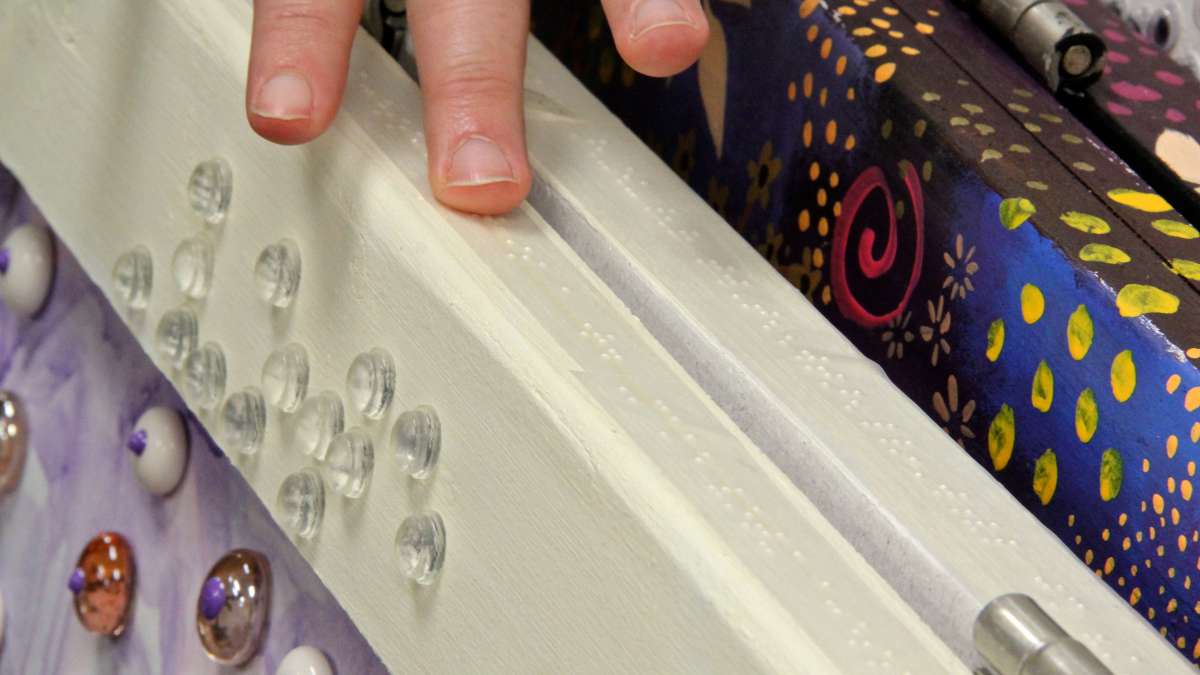Thanks to democracy group and Philly artists, signs point to voting
Listen-

-

-

-

-

-

-

-

Local artists created signs to encourage voter participation. (Emma Lee/WHYY)
Twenty voting sites in Philadelphia will feature artwork by 60 local artists — three pieces per site — in an effort to make polling places kinder, gentler.
“It’s not cheery. It’s not bright, engaging, or energetic,” said Lansie Sylvia, said of the voting process. Sylvia is all those things — in addition to being project manager of Next Stop Democracy.
“We’re trying to bring a culture of celebration back to the civic process, especially in Philadelphia, where we have not been awesome about voting in the past few elections,” she said.
With a $166,000 grant from the Knight Foundation, Sylvia asked five dozen artists to make sandwich boards according to their own artistic vision. She asked that the boards be nonpartisan, not advocating how to vote, only encouraging the act of voting. The words “Vote Here” were required on one side, and, on the other, “Vote Aqui.”
Those artists include prominent street artist NoseGo, prankster Kid Hazo, yarnbomber Ishknits, photographer Dominic Esposito, and legendary mosaic artist Isaiah Zagar.
Twelve of the signs were made by artists inside Graterford Prison, through the Mural Arts Program’s Restorative Justice project. Some of them are incarcerated for life and will never be able to vote.
Many of the artists were rounded up by Conrad Brenner, founder and editor of the street art blog, StreetsDept.com. He was inspired by the extremely popular pop-up parks and beer gardens appearing temporarily around Philadelphia in the summertime, attracting tens of thousands of people to the Delaware River, the Parkway’s Eakins Oval, and vacant lots around town.
“We wanted to take that framework and apply it to Election Day,” said Brenner. “All this art — 60 original pieces of art — many of which are from some of Philadelphia’s most celebrated, acclaimed street artists, is on going to be on the streets for just one day.”
In 1971, voter turnout reached the high-water mark when more than 76 percent of eligible voters decided between Frank Rizzo and Thacher Longstreth for mayor. That was 44 years ago. Since then, turnout has been in steady decline. In 2007, Michael Nutter was elected mayor with about 28 percent turnout. Tuesday’s mayoral contest is expected to be decided by even fewer voters.
“Think about how much Philadelphia has changed in the last eight years,” said Sylvia. “We see a lot energy in the last few years, especially from young people, a lot of positive indicators that the city is on the up-and-up. Yet this very crucial part of citizenry — being a citizen in Philadelphia — continues to stagnate if not decline.”
The sidewalk art exhibitions are meant to build a sense of community. Next Stop Democracy has a strong social media component, wherein all the participating artists are required to upload a photo of their work to Twitter or Instagram on Election Day. The activity on the sidewalk and in cyberspace is meant to alleviate the loneliness of voting, where a young first-time voter might find himself or herself casting a ballot in an empty room.
“A lot of people think it’s Nov. 4, because that’s the day Obama was elected eight years ago. It was our generation’s most memorable Election Day,” said Brenner. “To this day, I have people saying, ‘Oh, it’s Nov. 4.’ No, it’s Nov. 3.”
Next Stop Democracy will place its own pollsters at each of the 20 sites, as well as 20 additional sites with no artwork on display, to survey voters about their experiences. By comparing the activated sites with the control group, the group hopes to learn if it made a difference, and how the experiment could be replicated in other cities.
Originally, Next Stop Democracy was going to include sidewalk performances — featuring musicians, dancers, improv comedians, and artists — creating mini-street festival outside of polling places. Sylvia tried to partner with schools and civic groups to stage events, but was quickly shut down.
“We were surprised by how politicized the civic engagement process has become,” said Sylvia. “We heard from one school, ‘We just feel like encouraging people to vote is a little too political for us.’ That was something we heard from sponsors and potential partners. Just the idea of a get-out-the-vote effort felt too political.”
One of the artists, Joe Burochow, has created political wheat-paste prints around Election Day in the past, but usually with a more opinionated agenda. For this project, he created a cut-out silhouette of a person with his head stuck in a locked ballot box, reacting to what he calls the “confusion and frustration” of the campaign and election process.
“I tried to keep it nonpartisan, but it hard not to be political when you are doing a piece of art about voting,” said Burochow. “It’s impossible to decouple the two.”
All the work can be seen by following the hashtag #VoteNov3rd.
WHYY is your source for fact-based, in-depth journalism and information. As a nonprofit organization, we rely on financial support from readers like you. Please give today.





